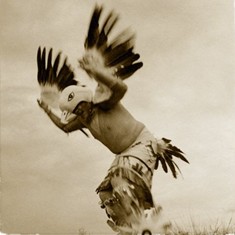 The way that Civil War history is written, you’d think that the conflict was confined to the easternmost quarter of the nation. But though few significant battles took place on the western frontier, the region wasn’t exactly unscathed. In the vast area known then simply as “Indian Country,” for example, tribes split along factional lines—many chieftains entered into alliances with the Confederacy, lured in by promises of territorial protection should the South emerge victorious. But some Creek and Seminole leaders refused to go along with this plan, and led thousands of followers into Kansas to join forces with the Union.
The way that Civil War history is written, you’d think that the conflict was confined to the easternmost quarter of the nation. But though few significant battles took place on the western frontier, the region wasn’t exactly unscathed. In the vast area known then simply as “Indian Country,” for example, tribes split along factional lines—many chieftains entered into alliances with the Confederacy, lured in by promises of territorial protection should the South emerge victorious. But some Creek and Seminole leaders refused to go along with this plan, and led thousands of followers into Kansas to join forces with the Union.
The first of these “refugee Indians” mustered out of Leroy, Kansas, in 1862. As the First Indian Home Guard Regiment prepared to enter the war on the Union’s behalf, The New York Times posted an eyewitness (and somewhat racist) account of their pre-battle religious rites. What draws our interest here, of course, is the allusion to magic rendering human flesh immune to bullets—a topic of great fascination ’round Microkhan HQs every since we embarked on our semi-regular Bulletproof Project:
They first have a preparation of roots, boiled up in two large kettles; they take a pint cup full of each, which produces immediate and violent vomiting; then they have prepared a camp fire and a large circle; around it they dance a very laborious and ludicrous dance, keeping up a song or kind of “yahoo,” responded to or echoed by all the dancers, which frequently number three or four hundred. The music resembles the corn songs at corn-huskings in the South. During their exercises they have their enchanters around at different points, to invoke the good spirits to aid them in their orgies. They keep this up all night, vomiting and dancing, and just at daylight they all run to the river and jump in, and remain some minutes in the water, no matter how cold; this, they think, makes them impervious to bullets or sickness; and should any die that have gone through the operation, he had either not vomited enough, ot danced hard enough, not stayed in the water long enough, or some other defect in performance.
Is it just us, or are does the state of intoxication here sound an awful like the result of peyote consumption? If so, the use of the drug for religious rites was far more widespread in the mid-19th century than we previously realized.


Jordan // Jan 14, 2010 at 1:16 pm
Given that peyote would be a low-mass, high-value commodity, it’s pretty ideal for trading. Wouldn’t shock me if it made it around the country.
Brendan I. Koerner // Jan 14, 2010 at 1:26 pm
I just always thought it was an exclusively southwestern phenomenon, at least until the 20th century. But I guess the ritual had made it’s way up to Oklahoma by the 1860s, too–assuming the “roots” the eyewitness refers to are, indeed, peyote. I just thought the uncontrollable vomiting was a tip-off.